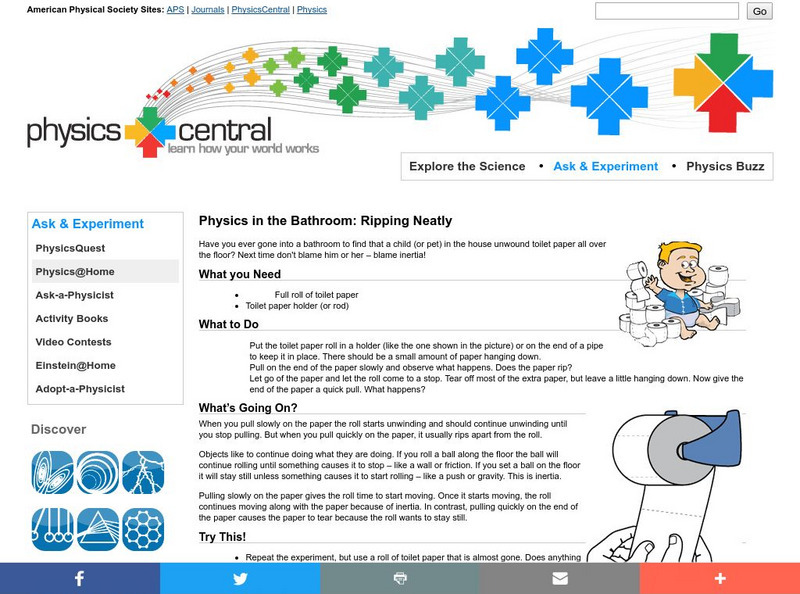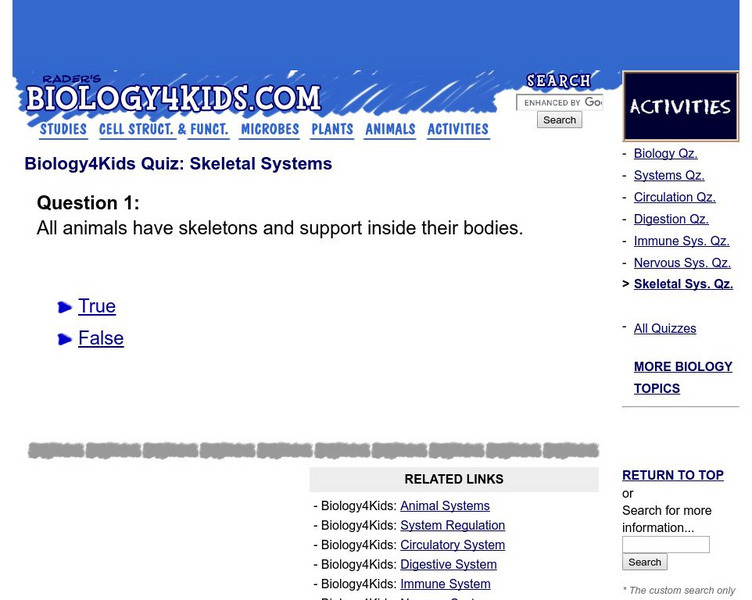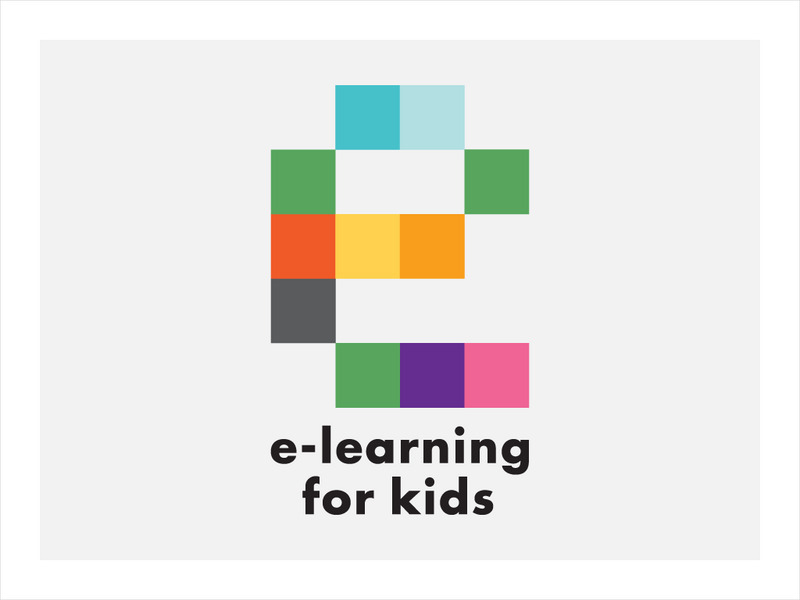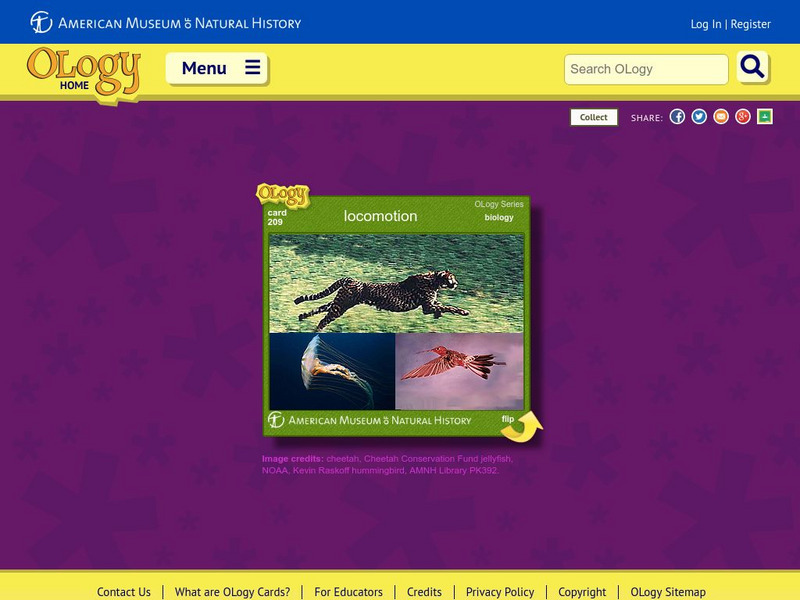Other
Bscs: Forces Lesson 2: Representing Forces
What makes something start to move? What makes something stop moving or change direction? This hands-on lesson will show learners that forces acting on an object have a strength and a direction that can be represented by arrows of...
Physics Central
Physics Central: Physics in the Bathroom: Ripping Neatly
A great science experiment to demonstrate Newton's First Law of Motion, inertia. There is a step-by-step guide on how to conduct this experiment and links to other sites about inertia.
Art Cyclopedia
Artcyclopedia: Early Renaissance Art
Here at Artcyclopedia you find a very brief explanation of the Early Renaissance along with many links out to the artists related to the movement.
Biology 4 kids
Biology4 Kids: Quiz: Skeletal Systems
Take this ten-question review quiz over the skeletal systems of animals. Read more about each question after an incorrect answer is given.
E-learning for Kids
E Learning for Kids: Science: Diving School: How Do We Move?
Mariven lives in Barbados. He is going on a diving adventure to learn all about bones and muscles of the human body.
E-learning for Kids
E Learning for Kids: Science: Antarctica: Penguins: What Is Motion?
What do you know about Emperor penguins? Ernie is researching them and their migration across the continent.
E-learning for Kids
E Learning for Kids: Science: Indian Ocean: Pirates: What Makes Things Move?
Join Pirates Slim Jim and Easy Finn on their boat. There, learn more about how to move objects.
PBS
Pbs Learning Media: Gravity of the Situation
Gravity of the Situation asks students to describe what role gravity plays on the movement of the three groups of kids in the video.
ArtLex
Art Lex: Movement
This site from Artlex is a fantastic description of how movement is used in the creation of art. There are links to works of art in sculpture, painting and photography as well as focused interpretations of how different types of movement...
ArtLex
Art Lex: Rhythm
This site from Artlex provides a thorough definition of the Principle of Design known as Rhythm. There are links to other sources and terms as well as visuals from artists such as Klee, Matisse and Mondrian that show further examples.
Project Britain
Primary Homework Help: Forces Quiz
First, read some fast facts about forces, then take a ten-question, multiple-choice quiz. Check to see if your answers are correct after each question.
Minneapolis Institute of Arts
Arts Connect Ed Artist's Toolkit Encyclopedia: Rhythm
An interactive site that explores the elements and principles of visual art through the artist's toolkit. This encyclopedia entry on rhythm and movement covers rhythm and repetition, alternating rhythm, and rhythm and movement.
TED Talks
Ted: Ted Ed: The Surprising (And Invisible) Signatures of Sea Creatures
On land, animals leave footprints that tell us a lot about their size, form and capabilities. Marine organisms do this too, but these footprints are harder to see since water is translucent. Bioengineer Kakani Katija explains how she...
TED Talks
Ted: Ted Ed: Why Don't Ants Get Stuck in Traffic?
Last year Americans wasted nearly 1 million collective years staring at each others' tailpipes. But there is another species on earth whose population numbers in the trillions, but who doesn't get stuck in traffic - how? It's Ok to be...
TED Talks
Ted: Ted Ed: Why Sitting Is Bad for You
Sitting down for brief periods can help us recover from stress or recuperate from exercise. But nowadays, our lifestyles make us sit much more than we move around. Are our bodies built for such a sedentary existence? Murat Dalkilinc...
PBS
Science Odyssey: Heisenberg States Uncertainty Principle
Explains the Heisenberg Uncertainty Principle, that it is impossible to know both the momentum and position of an electron, along with describing the impact that it made upon the scientific community upon its introduction in 1927.
TED Talks
Ted: Ted Ed: The Great Brain Debate
Throughout history, scientists have proposed conflicting ideas on how the brain carries out functions like perception, memory, and movement. Is each of these tasks carried out by a specific area of the brain? Or do multiple areas work...
Other
Recreation & Health for Children
Japanese content. The site aims to promote physical fitness for children and provides news items and information on fitness tests, how to exercise, where you to play sports, and how to promote an active and healthy lifestyle. You can...
Center of Science and Industry
Cosi Columbus: Big Wave
Investigate the behavior of a string of rubber bands and clips, and discover why it produces patterns of movement called waves. Includes full list of materials, procedures, and scientific explanation of what causes different types of waves.
Orpheus Books
Q Files: Animals: Animal Movement
Find out the many different ways that animals move through their environments.
OpenStax
Open Stax: Anatomy & Physiology: Skeletal System Functions
This site helps you understand the human skeletal system, a body system composed of bones and cartilage that performs critical functions for the human body.
Solomon R. Guggenheim Foundation
Guggenheim: Josef Albers
This resource provides a biography of Josef Albers and links to related topics.
TeachEngineering
Teach Engineering: Move Your Muscles!
This lesson plan covers the topic of muscles. Students learn about the three different types of muscles in the human body and the effects of microgravity on muscles. Students also learn how astronauts need to exercise in order to lessen...
American Museum of Natural History
American Museum of Natural History: Locomotion O Logy Card
Investigate the locomotion of animals by flipping over this OLogy card. Find fast facts, questions and answers, and similar bite-size pieces of information about how animals move.



















